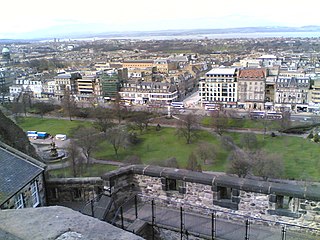 W
WThe New Town is a central area of Edinburgh, the capital of Scotland. A masterpiece of city planning, it was built in stages between 1767 and around 1850, and retains much of its original neo-classical and Georgian period architecture. Its best known street is Princes Street, facing Edinburgh Castle and the Old Town across the geological depression of the former Nor Loch. Together with the Old Town, the New Town was designated a UNESCO World Heritage Site in 1995.
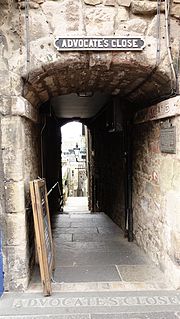 W
WAdvocates Close is a narrow and steep alley in Edinburgh of medieval origin, redeveloped in the early 21st century. With a multiplicity of steps it is not accessible to disabled persons.
 W
WThe Assembly Rooms are meeting halls in central Edinburgh, Scotland. Originally solely a meeting place for social gatherings, it is now also used as an arts venue and for public events, including the Edinburgh Festival Fringe and the Hogmanay celebrations. There are four rooms, with moveable chairs or tables, that are used year-round and are available for private functions: Music Hall, Ballroom, Supper Room and Edinburgh Suite.
 W
WBute House is the official residence of the First Minister of Scotland located within Charlotte Square in Edinburgh, the capital city of Scotland. Alongside two other offices at Holyrood and St. Andrew's House, Bute House also has a smaller office used by the First Minister when in official residence.
 W
WCharlotte Square is a garden square in Edinburgh, Scotland, part of the New Town, designated a UNESCO World Heritage Site. The square is located at the west end of George Street and was intended to mirror St. Andrew Square in the east. The gardens are private and not publicly accessible.
 W
WThe Church of Scotland offices are located in the centre of Edinburgh, Scotland at 121 George Street. These imposing buildings are popularly known in Church circles as "one-two-one". They were designed in a Scandinavian-influenced style by the architect Sydney Mitchell and built in 1909-1911 for the United Free Church of Scotland. Following the union of the Church of Scotland and the United Free Church of Scotland in 1929 the church offices were henceforth used by the newly united church.
 W
WThe Dean Bridge spans the Water of Leith in the city of Edinburgh on the A90 road to Queensferry on the Firth of Forth. It carries the roadway, 447 feet (136 m) long and 39 feet (12 m) broad, on four arches rising 106 feet (32 m) above the river. The bridge was one of the last major works before retirement of the bridge designer, civil engineer Thomas Telford, and was completed in 1831 when he was seventy-three years old.
 W
WThe Dean Gardens are private communal gardens near the Stockbridge suburb of the New Town area of Edinburgh, EH4. The gardens lie over a 2.9 hectares sized site on the steep north bank of the Dean Valley through which runs the Water of Leith. A public view of the gardens can be seen from the Dean Bridge, under which the gardens lie. The gardens have been listed on the Inventory of Gardens and Designed Landscapes as part of the New Town gardens heritage designation since March 2001.
 W
WGeorge Drummond (1688–1766) was accountant-general of excise in Scotland and a local politician, elected Lord Provost of Edinburgh a number of times between 1725 and 1764.
 W
WDundas House is a Neoclassical building in Edinburgh, Scotland. It is located at 36 St Andrew Square, in the city's first New Town. The building was completed in 1774 as a private town house for Sir Lawrence Dundas by the architect Sir William Chambers. Much altered internally and extended over the years, today it is the registered office of the Royal Bank of Scotland and its parent, NatWest Group and is protected as a category A listed building.
 W
WEdinburgh Bus Station is the bus station serving central Edinburgh, which opened in its present form in February 2003.
 W
WEdinburgh Waverley railway station is the principal station serving Edinburgh, Scotland. It is the second busiest station in Scotland, after Glasgow Central. It is the northern terminus of the East Coast Main Line, 393 miles 13 chains (632.7 km) from London King's Cross, although some trains operated by London North Eastern Railway continue to other Scottish destinations beyond Edinburgh.
 W
WThe General Register Office for Scotland (GROS) was a non-ministerial directorate of the Scottish Government that administered the registration of births, deaths, marriages, divorces and adoptions in Scotland from 1854 to 2011. It was also responsible for the statutes relating to the formalities of marriage and conduct of civil marriage in Scotland. It administered the census of Scotland's population every ten years. It also kept the Scottish National Health Service Central Register.
 W
WGeorge Street is the central thoroughfare of the First New Town of Edinburgh, planned in the 18th century by James Craig.
 W
WHeriot Row is a highly prestigious street in central Edinburgh, virtually unchanged since its original construction in 1802. From its inception to the present day in remained a top address in the city and has housed the rich and famous of the city's elite for 200 years
 W
WJenners is a well established department store in Edinburgh, Scotland, situated on Princes Street. It was Scotland's oldest independent department store until it was acquired by House of Fraser in 2005.
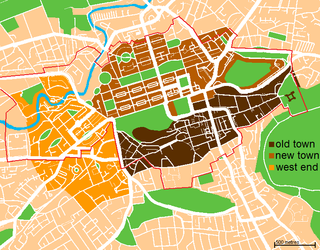 W
WThis is a list of Category A listed buildings in the New Town of Edinburgh, Scotland.
 W
WLondon Road Gardens are located close to the city centre of Edinburgh in the New Town, part of the UNESCO World Heritage Site inscribed in 1995. They occupy a long strip of land from east to west along the lower northern slope of Calton Hill, with an area of 4.37 hectares. The gardens are notable for their large, old trees including limes and some fine, surviving elms, also spring flowers, particularly daffodils.
 W
WThe Melville Monument is a 150-foot high monumental column. One of the most prominent memorials in Edinburgh, it commemorates Henry Dundas, 1st Viscount Melville, whose statue surmounts the column.
 W
WThe Moray Estate in Edinburgh was an exclusive early 19th century building venture attaching the west side of Edinburgh's New Town.
 W
WMultrees Walk is a pedestrian shopping area off the east side of St. Andrew Square, Edinburgh, Scotland. Created in 2003 as part of a redevelopment, it links St Andrew Square and St James Shopping Centre and its shops sell luxury goods including clothing, stationery and handbags.
 W
WThe New Club is a private social club in the New Town area of Edinburgh, Scotland. Founded in 1787, it is Scotland's oldest club. The club occupied premises on St Andrew Square from 1809 until 1837, when it moved to purpose-built rooms on Princes Street. The 1837 building was replaced with a modern building to a design by Reiach and Hall, which is protected as a category A listed building. Women were admitted in 1970, and offered full membership from 2010. Prince Philip, Duke of Edinburgh has been the Patron of the Club since 1952. The only stated requirements for membership are that a candidate is over 18 and is "clubbable".
 W
WNew Register House is the main building of the General Register Office for Scotland, located near St Andrew Square to the east end of Princes Street in the New Town of Edinburgh, Scotland. It also houses the Accountant in Bankruptcy and the Court of the Lord Lyon and housed the Office of Director of Chancery until its abolition in 1928.
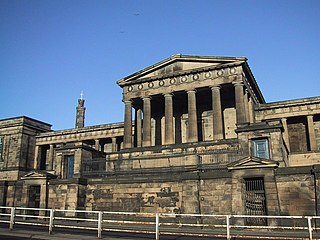 W
WThe Old Royal High School, also known as New Parliament House, is a 19th-century neoclassical building on Calton Hill in the city of Edinburgh. The building was constructed for the use of the city's Royal High School, and gained its alternative name as a result of a proposal in the 1970s for it to house a devolved Scottish Assembly.
 W
WPrinces Street Gardens are two adjacent public parks in the centre of Edinburgh, Scotland, lying in the shadow of Edinburgh Castle. The Gardens were created in the 1820s following the long draining of the Nor Loch and building of the New Town, beginning in the 1760s.
 W
WInterContinental Edinburgh The George is a historic hotel located at 19–21 George Street in Edinburgh, the capital of Scotland.
 W
WQueen Street is an early east-west street in the Edinburgh New Town. It begins in the east, at the Scottish National Portrait Gallery. It links York Place with the Moray Estate.
 W
WRegent Bridge is a road bridge in Edinburgh, Scotland, where the A1 road enters the New Town from the east and passes over a hollow near Calton Hill. The bridge was built in the 19th century, in the neoclassical style as the medieval city was modernised and expanded to the north and east.
 W
WThe Regent, Royal and Carlton Terrace Gardens are private communal gardens in the New Town area of Edinburgh, EH7. They lie over a 4.8-hectare (12-acre) site on the east side of Calton Hill. The gardens have been listed on the Inventory of Gardens and Designed Landscapes as part of the New Town gardens heritage designation since March 2001.
 W
WRose Street is a street in the New Town of Edinburgh, Scotland. It is a narrow street running parallel between Princes Street and George Street. Today, it is principally a shopping street, however, it is well known for its many bars and public houses.
 W
WThe Royal Scottish Academy (RSA) is the country’s national academy of art. It promotes contemporary Scottish art.
 W
WThe Royal Scottish Academy building, the home of the Royal Scottish Academy, is situated on The Mound in the centre of Edinburgh, was built by William Henry Playfair in 1822-6 and extended in 1831-6 for the Board of Manufactures and Fisheries. Along with the adjacent National Gallery of Scotland, their neo-classical design helped transform Edinburgh into a modern-day Athens of the North.
 W
WThe Royal Society of Edinburgh is Scotland's national academy of science and letters. It is a registered charity, operating on a wholly independent and non-party-political basis and providing public benefit throughout Scotland. It was established in 1783. As of 2017, it has more than 1,660 Fellows.
 W
WSt Andrew's and St George's West Church serves Edinburgh's New Town, in Scotland. It is a congregation of the Church of Scotland. The parish today constitutes the whole of the First New Town of Edinburgh and a small part of the early-19th-century Second New Town of Edinburgh. The church building was completed in 1784, and is now protected as a category A listed building.
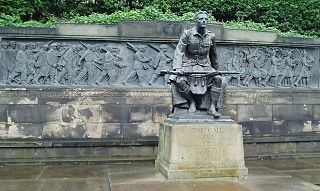 W
WThe Scottish American Memorial, or Scots American War Memorial, is in West Princes Street Gardens in Edinburgh. It was called "The Call 1914", and it was erected in 1927 and shows a kilted infantryman looking towards Castle Rock. Behind the main statue is a frieze showing queues of men answering the call by following a kilted pipe band. The memorial was given by Scottish-Americans to honour Scots who had served in the first World War.
 W
WThe Scottish National Gallery is the national art gallery of Scotland. It is located on The Mound in central Edinburgh, close to Princes Street. The building was designed in a neoclassical style by William Henry Playfair, and first opened to the public in 1859.
 W
WWilliam Sibbald (c.1760–1809) was a Scottish architect. He was superintendent of public works in Edinburgh and assisted Robert Reid in setting out and designing the Second New Town.
 W
WSt Andrew Square is a city square in Edinburgh, Scotland located at the east end of George Street. The gardens are owned by a number of private owners, managed by Essential Edinburgh and opened to the public in 2008. The construction of St Andrew Square began in 1772, as the first part of the New Town, designed by James Craig. Within six years of its completion St Andrew Square became one of the most desirable and most fashionable residential areas in the city. As the 19th century came to a close, St Andrew Square evolved into the commercial centre of the city.
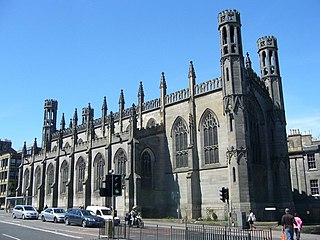 W
WSt Paul's and St George's Church is an evangelical church of the Scottish Episcopal Church in central Edinburgh, Scotland. It is located on the corner of Broughton Street and York Place in the east end of Edinburgh's New Town, and is protected as a category A listed building.
 W
WSaint Stephen's Church is located in the New Town of Edinburgh, Scotland, at the bottom of Saint Vincent Street. It was built in 1827-1828, to a design by architect William Henry Playfair (1789–1857).
 W
WThe Waterloo Hotel is a historical hotel located on Waterloo Place in Edinburgh, Scotland. It was the first large scale purpose built hotel in Edinburgh, trading from 1819 to 1898.
 W
WYork Place is a street in central Edinburgh of almost exclusively 18th century buildings, linking Queen Street to Broughton Street and Leith Walk.